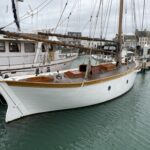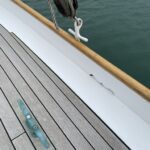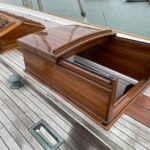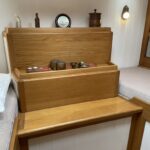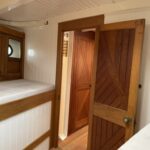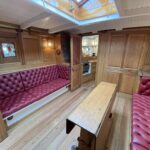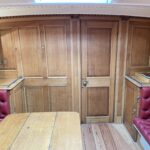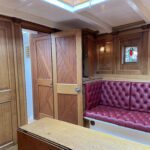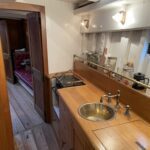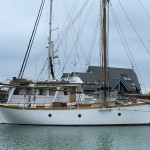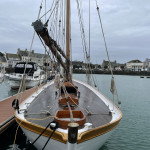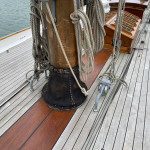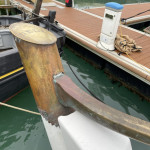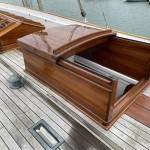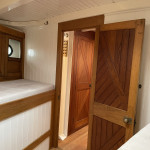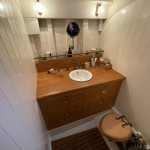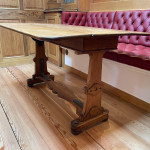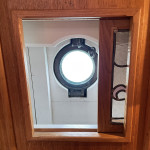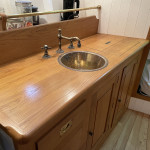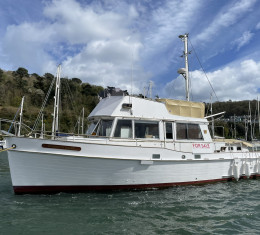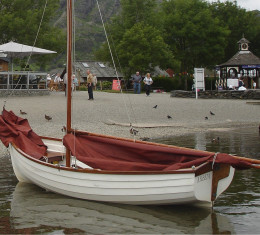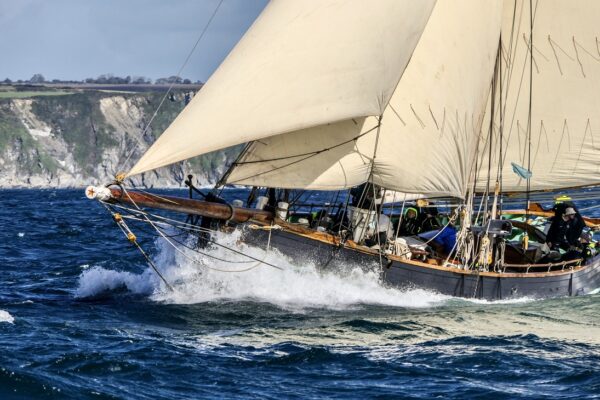Sailing yachts
Full specification
Wooden Ships Comments on this G.L. Watson Gaff Cutter
Designed by G.L. Watson and according to the Greenock Herald, she was launched on 24th April 1887 from the yard of Thomas Orr Jr. from his Greenock yard on the Clyde.
Rebuilt by the Chantier Bernard in St Vaast, France. Relaunched in 2017.
The yacht was built to a commission for Robert Cowan Robertson who was a student at the Glasgow School of Art and an exact contemporary of Charles Rennie Mackintosh.
The commission was No.134 for Watson with lines based on those of the Loch Fyne Skiff type fishing vessels which have a very distinctive stern, generous freeboard and a straight stem.
One of her defining features is her interior and most of the salon joinery is original. Her elaborate decor was a result of Robertsons wealth and artistic inclinations and is characteristic of Clydeside fashionable interiors of the time. One of her most notable features is a pair of stained glass sliding panels depicting a stylised Scottish thistle very much in the ‘Glasgow’ style, and although highly unusual for a yacht interior, they represent the true essence of this yacht, her history and her period.
The raised and fielded oak panelling, fluted pilasters, Ionic capitals and egg and dart cornice throughout the saloon represent the highest possible standard of joinery.
Bought by the present owner in 2009, there then started a major rebuild of the boat involving every facet of the hull, rig, systems and interior. The keel came off, stem replaced, 80% new planking and frames. Complete new deck structure and interior replaced or refurbished with all new systems and a complete new rig. This remarkable rebuild was imagined by the yachts eccentric owner whos ambition, vision and drive have helped give a new lease of life to this unique yacht.
The yacht was launched again in 2017.
This yacht is a completely unique piece of maritime history, unusual in her design, rich in history and pedigree and with a stunning interior first conceived and fitted over 125 years ago.
Length on Deck 13.95m / 45’10”
Length Overall
Length Waterline 13.7m / 45’
Beam 3.65m / 12’
Draft 2.35 / 7’
Thames Tonnage 26TM
Construction
- Around 80% of the planking and 80% of the frames were replaced during the rebuild process.
- Arvel planked in Oregon Pine with oak garboards. Fastened with hot dipped galvanised boat nails to sawn oak frames.
- Frames are approximately 3” x 3” at 9.5” centres.
- Stainless steel strap floors have been fabricated across the centreline. Grown oak floors are also used in certain parts of the hull.
- External iron ballast keel fastened with new stainless steel keel bolts.
- The whole deck structure was new in the rebuild, consisting of oak deck beams with straight laid teak deck planking, caulked and payed. Varnished teak king plank and painted covering boards. Varnished oak toe rail.
- Hatches and skylights in varnished teak. All are original and rebuilt except for the main companionway hatch which is new.
- Stern post hung rudder with the original bronze rudder cap inscribed with the yachts name and original bronze tiller.
Rig
- Gaff cutter rig on a keel stepped hollow section spruce mast, new in the rebuild, with a fidded topmast.
- Galvanised wire standing rigging all new in the refit. Dead eyes and lanyards to external galvanised chain plates set over channel boards.
- Running backstays set up to tackles.
- Bowsprit sets through a gammon iron and can be run inboard. Galvanised whisker stays tensioned with tackles.
- Slab reefing boom with lazyjacks.
- All sheets and halyards are on tackles with no winches fitted.
- All sails new from James Lawrence in ? Include mainsail, topsail, staysail, jib and jib topsail.
Machinery
- Volvo Penta D3-110 110hp 4cyl turbo charged diesel engine installed new during the rebuild.
- V-drive gearbox means the engine sits in reverse over the top of the shaft and does not intrude into the aft cabin.
- Stainless steel shaft with a Deep Sea Seal stern gland to a centreline 3 blade feathering Darglow propeller.
- 3 x 125ah 12 volt batteries for engine starting and domestic use. Charged from the engine alternator or through the 25 amp Quick Energy shore power charger.
- 12 volt switch panel has modern switches and wiring but these are faced older style bronze toggle switches in keeping with the yacht. The whole yacht was completely re-wired in the rebuild.
- Studer sine wave inverter.
- 233 litre stainless steel fuel tank.
- 2 x 250 litre stainless steel water tanks.
- 45 litre Vetus calorifier for domestic hot water, connected to the engine and 204 volt immersion coil.
Accommodation
- The interior of Nell is perhaps her defining feature, A saloon which remains exactly as it was at the time of her launch, designed by her first owner Robert Cowan Robertson. He would be as at home in the saloon today as he was in 1887.
- 4 single berths in 2 cabins.
- Headroom of 1.9m in the saloon, 1.96m in the galley and 2.1m in aft cabin.
- Centreline companionway drops into a free standing area with the heads to starboard and electrics/storage locker to port.
- The heads compartment has a Baby Blake sea toilet which discharges directly overboard. Oak side board with a round hand basin that has hot and cold pressurised water. Sheathed shower tray with a teak grating drains into a grey water tank. Pull out shower head by the basin.
- Original panelled oak door with bronze fittings leads into the aft cabin. Here there are 2 large single berths with some oak joinery and shelves covering the forward end of the engine. The berths are new but the oak drawers below are original. Varnished teak skylight above.
- Moving forward through the port offset panelled door into the exquisite saloon.
- Starboard side dropleaf oak table with a leather Chesterfield buttoned settee either side.
- Original raised and fielded oak panelling, fluted pilasters, Ionic capitals and egg and dart cornice throughout the saloon make this a totally unique yacht and give the saloon a very special feel.
- Of all the joinery features, the pair of stained glass sliding panels depicting a stylised Scottish thistle are particularly notable.
- In each corner of the saloon is a locker and small side board.
- Large varnished teak skylight above.
- Port side panelled door going forward. The forecabin has the galley on the port side and 2 single berths to starboard.
- Galley has oak worktops and joinery with a Taylors 030 paraffin stove with oven, top loading 12 volt fridge compartment and a basin with hot and cold pressurised water.
- Forepeak is used solely for storage and provides a large easily access space for sails, fenders etc.
Equipment
- B&G chartplotter
- B&G V50 DSC VHF
- B&G remote handset for VHF
- B&G sounder and log
- Cassens and Plath Zeta steering compass
- Jack stays
- Manual bilge pump
- 3 x Auto electric bilge pumps
- Fire extinguishers
- Fire blanket
- Studer sine wave inverter
- Quick Energy SBC 250 NRG 25 amp 12 volt battery charger
- 3 x 12 volt 125ah batteries
- 45 litre Vetus calorifier
- Bunk and berth cushions
- Taylors 030 paraffin stove
- 12 volt fridge compartment
- Galley equipment
- Baby Blake sea toilet
- Manual anchor windlass
- 60lb CQR anchor
- Ample galvanised chain
- Fenders
- Mooring warps
- Boat hook
- Mainsail
- Topsail
- Staysail
- Jib
- Jib topsail
- Sail bags
- Mainsail cover
- Hatch, skylight and cockpit covers
Wooden Ships classic yachts brokers have an extensive database of boats for sale. With a wide range of sailboats, classic yachts, motor yachts and small classic boats, Wooden Ships has one of the largest selections of traditional wooden boats and yachts for sale in the UK.
Disclaimer:
These particulars have been prepared in good faith from information provided by the Vendors and are intended as a guide, Wooden Ships cannot guarantee or warrant the accuracy of this information nor warrant the condition of the vessel. The Purchaser should instruct his agent or surveyor to validate all details as necessary and satisfy himself with the condition of the vessel and its equipment.



